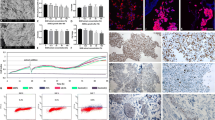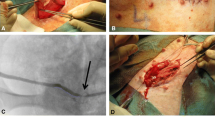Abstract
Purpose
To evaluate the cellular survival of donor fibroblasts after transplantation at the vesico-ureteral junction (VUJ) and to analyse their potential for reconstructive cell replacement in an animal model as autologous fibroblasts have been used as soft tissue augmentation material for scared and damaged tissue.
Methods
Muscles biopsies were procured from the lower limb muscles of 4 pigs; cytoplasm of fibroblasts was labelled with nano-sized iron oxide particles. Six weeks after taking of the muscle biopsies, fibroblast transplantation was performed, 3 × 106 cells suspended in transplantation medium (in 1-ml syringes) were injected at the VUJ using the modified STING technique. Animals were killed 8 weeks later; seeded fibroblasts were identified using prussian blue staining protocol; histological evaluation and morphological analysis were performed by light microscopy (Mayer’s haematoxylin-eosin staining); and bladders were scanned by MRI for visualization and localization of the iron-labelled donor cells.
Results
Donor fibroblast cell colonization and cellular viability at the VUJ was demonstrated by MRI and histochemically indicating cellular uptake of iron particles at the VUJ. It was also evident that transplanted fibroblasts integrate into the extracellular matrix of the distal ureter augmenting ureteral host tissue.
Conclusions
Labelled implanted autologous fibroblasts were visualized by staining procedure as well as MRI scan demonstrating persistence at the VUJ, suggesting that in vitro expanded fibroblasts survived in vivo after transplantation.


Similar content being viewed by others
References
Fuchs E, Segre JA (2000) Stem cells: a new lease on life. Cell 100:143–155
Murphy KE, Hall CL, Maini PK, McCue SW, McElwain DL (2012) A fibrocontractive mechanochemical model of dermal wound closure incorporating realistic growth factor kinetics. Bull Math Biol 2012 Jan 13 [Epub ahead of print]
Obaid H, Clarke A, Rosenfeld P, Leach C, Connell D (2012) Skin-derived fibroblasts for the treatment of refractory Achilles tendinosis: preliminary short-term results. J Bone Joint Surg Am 94(3):193–200
Eça LP, Pinto DG, de Pinho AM, Mazzetti MP, Odo ME (2012) Autologous fibroblast culture in the repair of aging skin. Dermatol Surg 38(2):180–184
Zini L, Yiou R, Lecoeur C, Biserte J, Abbou C, Chopin DK (2004) Tissue engineering in urology. Ann Urol (Paris) 38(6):266–274
Matuszewski L, Persigehl T, Wall A, Schwindt W, Tombach B, Fobker M, Poremba C, Ebert W, Heindel W, Bremer C (2005) Cell tagging with clinically approved iron oxides: feasibility and effect of lipofection, particle size, and surface coating on labeling efficiency. Radiology 235(1):155–61 [Epub 2005 Mar 4]
Coulthard MG (2009) Vesicoureteric reflux is not a benign condition. Pediatr Nephrol 24(2):227–32 [Epub 2008 Jun 27]
Ninan GK, Singh Jutley R, Eremin O (1999) Urinary cytokines as markers of reflux nephropathy. J Urol 162:1739–1742
Yu RN, Roth DR (2006) Treatment of vesicoureteral reflux using endoscopic injection of nonanimal stabilized hyaluronic acid/dextranomer gel: initial experience in pediatric patients by a single surgeon. Pediatrics 118:698–703
Routh JC, Inman BA, Reinberg Y (2010) Dextranomer/hyaluronic acid for pediatric vesicoureteral reflux: systematic review. Pediatrics 125(5):1010–1019 [Epub 2010 Apr 5]
Kirsch AJ, Perez-Bayfield M, Smith EA, Scherz HC (2004) The modified sting procedure to correct vesicoureteral reflux: improved results with submucosal implantation within the intramural ureter. J Urol 171(6, part1):2413–2426
Capozza N, Caione P (2008) Modification of the sting procedure for vesicoureteral reflux: ureteral repositioning and injection. Arch Esp Urol 61(2):254–257
Oswald J, Riccabona M, Lusuardi L, Bartsch G, Radmayr C (2002) Prospective comparison and 1-year follow-up of a single endoscopic subureteral polydimethylsiloxane versus dextranomer/hyaluronic acid copolymer injection for treatment of vesicoureteral reflux in children. Urology 60(5):894–897 (discussion 898)
Sugiyama T, Hanai T, Hashimoto K, Umekawa T, Kurita T (2004) Long-term outcome of the endoscopic correction of vesico-ureteric reflux: a comparison of injected substances. BJU Int 94(3):381–383
Diamond DA, Caldamone AA (1999) Endoscopic correction of vesicoureteral reflux in children using autologous chondrocytes: preliminary results. J Urol 162(3 Pt 2):1185–1188
Caldamone AA, Diamond DA (2001) Long-term results of the endoscopic correction of vesicoureteral reflux in children using autologous chondrocytes. J Urol 165(6 Pt 2):2224–2227
Paltiel HJ, Diamond DA, Zurakowski D, Drubach LA, Atala A (2004) Endoscopic treatment of vesicoureteral reflux with autologous chondrocytes: postoperative sonographic features. Radiology 232(2):390–397 [Epub 2004 June 23]
Mitterberger M, Marksteiner R, Schwaiger W et al. (2008) Can autologous myoblasts be used as a potential bulking agent? BJU Int 102(11):1731–1736 [Epub 2008 Sep 3]
Pollack S (1999) Some new injectable dermal filler materials: Hylaform, Restylane and Artecoll. J Cutan Med Surg 3(Suppl 4):S27–S35
Solakoglu S, Tiryaki T, Ciloglu SE (2008) The effect of cultured autologous fibroblasts on longevity of cross-linked hyaluronic acid used as a filler. Aesthet Surg J 28(4):412–416
Kanzaki M, Yamato M, Yang J et al (2007) Dynamic sealing of lung air leaks by the transplantation of tissue engineered cell sheets. Biomaterials 28:4294–4302
Kovac EJ (1991) Fibrogenic cytokines: the role of immune mediators in the development of scar tissue. Immunol Today 12:17–23
Martinez-Hernandez A (1994) Repair, regeneration and fibrosis. In: Rubin E, Farber JL (eds) Pathology. J B Lipincott, Philadelphia, pp 81–93
Rausch M, Sauter A, Fröhlich J, Neubacher U, Radü EW, Rudin M (2001) Dynamic patterns of USPIO enhancement can be observed in macrophages after ischemic brain damage. Magn Reson Med 46(5):1018–1022
Rausch M, Baumann D, Neubacher U, Rudin M (2002) In vivo visualization of phagocytotic cells in rat brains after transient ischemia by USPIO. NMR Biomed 15(4):278–283
Arbab AS, Bashaw LA, Miller BR, Jordan EK, Lewis BK, Kalish H, Frank JA (2003) Characterization of biophysical and metabolic properties of cells labeled with superparamagnetic iron oxide nanoparticles and transfection agent for cellular MR imaging. Radiology 229(3):838–846
Pawelczyk E, Arbab AS, Chaudhry A, Balakumaran A, Robey PG, Frank JA (2008) In vitro model of bromodeoxyuridine or iron oxide nanoparticle uptake by activated macrophages from labeled stem cells: implications for cellular therapy. Stem Cells 26(5):1366–75 [Epub 2008 Feb 14]
Van den Bogaerdt AJ, van der Slot A, Ulrich MMW, Zuurmond A, Bank RA, Middelkoop E (2003) Altered collagen crosslinking by subcutaneous fat fibroblasts during wound healing. Wound Rep Regen 11:A28
Acknowledgments
We would like to sincerely thank each and every reviewer who dedicated his or her time and expertise to reviewing our manuscripts and everybody who supported us and collaborated with us.
Conflict of interest
The authors declare that they have no conflicts of interest.
Author information
Authors and Affiliations
Corresponding author
Rights and permissions
About this article
Cite this article
Pichler, R., Klima, G., Richter, E. et al. Autologous fibroblast transplantation at the vesico-ureteral junction as potential reconstructive cell replacement in an animal model. World J Urol 31, 169–174 (2013). https://doi.org/10.1007/s00345-012-0914-1
Received:
Accepted:
Published:
Issue Date:
DOI: https://doi.org/10.1007/s00345-012-0914-1




